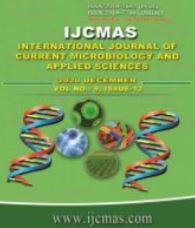


 National Academy of Agricultural Sciences (NAAS)
National Academy of Agricultural Sciences (NAAS)

|
PRINT ISSN : 2319-7692
Online ISSN : 2319-7706 Issues : 12 per year Publisher : Excellent Publishers Email : editorijcmas@gmail.com / submit@ijcmas.com Editor-in-chief: Dr.M.Prakash Index Copernicus ICV 2018: 95.39 NAAS RATING 2020: 5.38 |
Soils of Garud watershed in Bageshwar district of Uttarakhand state were assessed for distribution of macro and micronutrients viz. N, P, K, Ca, Mg, Na, Fe, Mn, Zn and Cu including soil texture, soil acidity and organic carbon content. The soil of the region was generally sandy-loam type with high organic matter content and acidic in nature. Soil was well drained with average thickness ranging from 0.1 to 0.5 m. The climate of the region is sub-tropical and humid with three distinct seasons. The average annual rainfall is about 1152 mm. The concentration of available primary nutrients nitrogen, phosphorus and potassium in the surface soil was found in the range of 310.14-400.03, 17.3-26.4 and 94.08-239.68 kg/ha, with the mean values of 330.37, 22.63 and 179.24 kg/ha, respectively, whereas in sub-surface soil it was in the range of 170.5-413.28, 13.2-23.2 and 78.4- 203.84 kg/ha with the mean values of 264.49, 18.47 and151.12 kg/ha, respectively. The concentration of available secondary nutrients calcium, magnesium and sodium in the surface soil was found in the range of 72.15-168.34, 53.64-92.66 and 21-59 mg/kg, with the mean values of 117.95, 78.02 and 35 mg/kg, respectively, whereas in sub-surface soil it was in the range of 88.18-192.38, 53.64-112.16 and 17 to 38 mg/kg, with the mean values of 146.95, 87.08 and 27.29 mg/kg, respectively. The concentration of available micronutrients Copper, Zinc, Manganese and Iron in the surface soil was found in the range of 0.11-0.35, 0.34-0.83, 1.58-2.82 and 30.3-82.6 mg/kg, with the mean values of 0.23, 0.56, 2.06 and 60.39 mg/kg, respectively, whereas in sub-surface soil it was found in the range of 0.20-0.34, 0.21-0.78, 0.15-2.10 and 22.3-73.8 mg/kg, with the mean values of 0.28, 0.51, 0.96 and 48.16 mg/kg, respectively. Soil EC showed positive and significant correlation with % silt, whereas, organic carbon showed positive and significant correlation with nitrogen, zinc and copper in surface soil. Available nitrogen showed the positive and significant correlation with the iron and copper, whereas, potassium and iron showed positive and significant correlation with zinc in surface soil. Organic carbon showed negative and significant correlation with the % sand but positive and significant correlation with the % clay, % silt + clay and available nitrogen in sub-surface soil. Per cent silt and % silt + clay showed positive and significant correlation with the available nitrogen, whereas, the potassium showed positive and significant correlation with the sodium and copper in sub-surface soil. Soil of the study area was deficient in DTPA extractable manganese (Mn) and zinc (Zn), whereas, nitrogen (N), phosphorus (P), potassium (K) and copper (Cu) content were in medium range. Iron (Fe) content of soil was very high in the soil of study area. Therefore, it could be recommended to enhance micronutrients availability in the study area soils. As carbon content of soil of the study area is high there is more scope for carbon sequestration in soil is net advantageous, improving the productivity and sustainability.
 |
 |
 |
 |
 |